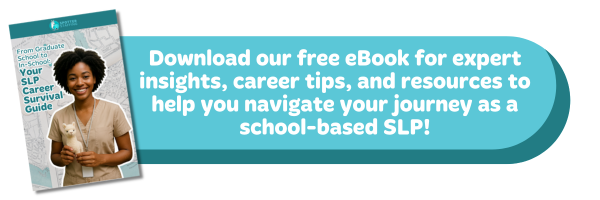May is Better Speech and Hearing Month—a time to celebrate the incredible work of speech-language pathologists (SLPs) and the amazing advancements shaping the field. As demand for SLPs in schools continues to grow, staying ahead of the latest trends and innovations is more important than ever. From AI-powered speech therapy tools to new intervention models, 2025 is shaping up to be a groundbreaking year.
Now is the perfect time to explore the trends transforming the profession. Whether you’re an experienced SLP or just starting your career, these innovations will help you provide better support for students while improving outcomes in your classroom.
AI and Machine Learning in Speech Therapy
Technology is revolutionizing how SLPs assess and treat students. AI-powered tools are making speech therapy more effective, engaging, and accessible, reducing the time needed for assessments and improving therapy outcomes.
- Automated speech analysis: AI-driven tools like SpeechPrism can analyze speech patterns in real time, identifying speech disorders faster and providing immediate feedback to both SLPs and students. This helps track progress efficiently and makes data-driven decisions easier.
- AI-driven therapy apps: These applications, like Huni, provide students with interactive exercises tailored to their specific needs. By using adaptive learning algorithms, you can adjust difficulty levels and suggest activities based on your students’ progress.
- Voice recognition software: New advancements in voice recognition help detect early signs of speech and language disorders, making screenings more accurate and reducing workload for SLPs. Try using an app like Braina to see the benefits of voice recognition software.
With AI-enhanced tools, SLPs can spend more time focusing on individualized care while leveraging data-driven insights to refine therapy plans. These innovations are making speech therapy more efficient and engaging for students.
Teletherapy: Expanding Access to Services
Telepractice has become a staple in school-based speech therapy, and in 2025, new advancements are taking it even further. Teletherapy allows schools to provide consistent services, even in areas with SLP shortages, ensuring all students receive the support they need.
Here are some of the ways teletherapy has helped school-based SLPs:
- Improved virtual therapy platforms: Today’s teletherapy platforms include interactive whiteboards, gamified exercises, and real-time progress tracking. AI integration allows for more accurate speech analysis and tailored intervention plans.
- Hybrid models: Many schools are adopting a hybrid approach, blending in-person and virtual therapy sessions to create flexible intervention plans. This allows SLPs to reach more students without being overwhelmed by large caseloads.
- VR-based speech therapy: Virtual reality is making its way into speech-language pathology, providing immersive experiences that make speech exercises more engaging and interactive. These VR tools help students build confidence in real-world communication scenarios.
With schools facing ongoing SLP shortages, teletherapy is proving to be a valuable tool for ensuring students receive high-quality speech and language support, no matter where they are.
Multisensory and Gamified Learning Approaches
Traditional speech therapy methods are evolving to incorporate multisensory approaches and gamification, making learning more engaging and effective for students. These techniques are especially helpful for children who struggle with motivation or attention.
- Augmented reality (AR) apps: AR technology allows students to interact with virtual objects and characters while practicing speech sounds and language skills, creating a more engaging learning experience. Try apps like Speech Blubs for fun AR inclusion for your students.
- Gamified therapy sessions: By incorporating game-like elements such as points, badges, and rewards, speech therapy becomes more motivating for students. Many apps, such as Articulation Station Hive, now feature competition-style exercises that encourage students to stay engaged.
- Sensory integration techniques: Many students benefit from tactile feedback, movement-based learning, or visual reinforcements. Incorporating multiple senses into therapy sessions helps reinforce speech and language skills.
These approaches cater to different learning styles and make speech therapy an enjoyable experience, leading to improved participation and outcomes.
Expanding the Role of SLPs in Schools
The role of SLPs in schools is expanding beyond traditional speech therapy sessions. Today’s SLPs are becoming key players in interdisciplinary teams, working alongside teachers, counselors, and special educators to provide holistic student support.
- Collaboration with teachers: SLPs are increasingly working with educators to integrate speech and language strategies into the classroom, helping students develop communication skills in everyday learning environments.
- Supporting mental health initiatives: Students can face challenges with social communication challenges, such as those with autism or anxiety disorders, and require extra support. SLPs are stepping into roles that address these needs, helping students build confidence and social skills.
- Early intervention programs: Schools are focusing more on early detection and intervention. SLPs work closely with school psychologists and counselors to identify and support students who show signs of speech and language difficulties as early as preschool.
By expanding their influence, SLPs are making an even greater impact on student success, ensuring communication skills are developed in various aspects of education and social life.
Culturally Responsive and Inclusive Therapy
As school populations become more diverse, the need for culturally responsive speech therapy has never been greater. SLPs are incorporating inclusive practices to ensure students from all backgrounds receive equitable support.
- Bilingual assessment tools: Many SLPs are utilizing new tools designed to accurately assess multilingual students, ensuring language differences are not mistaken for speech disorders.
- Culturally relevant materials: Therapy sessions are being adapted to include stories, activities, and examples that reflect students’ cultural backgrounds, making learning more relatable and effective.
- Advocacy for equitable access: SLPs are playing a crucial role in advocating for better speech therapy services for underserved communities, ensuring all students have the resources they need to succeed.
By embracing culturally responsive approaches, SLPs help create a more inclusive learning environment where every student can thrive.
Workforce Trends: Demand for SLPs in Schools
The demand for school-based SLPs is growing rapidly, creating new opportunities for those in the field. Schools are implementing creative strategies to attract and retain talented SLPs.
- Increased salaries and signing bonuses: Many schools are offering competitive salaries and incentives to fill SLP positions, recognizing the high demand for these professionals.
- SLP assistants (SLPAs): The use of SLPAs is expanding, allowing certified SLPs to focus on more complex cases while delegating routine tasks to trained assistants.
- Professional development and mentorship programs: Schools and agencies like Spotter Staffing are investing in training programs to help new SLPs transition into their roles more effectively, ensuring they receive the support they need.
With so many opportunities available, now is an excellent time to explore a career in school-based speech-language pathology.
Take the Next Step in Your SLP Career!
If you’re looking for exciting in-school SLP opportunities, Spotter Staffing can connect you with the perfect role. Whether you’re a recent graduate or an experienced professional, we’ll help you find the right fit.

Have questions or want to know more? Contact Spotter Staffing today and take the next step in your speech pathology career!


